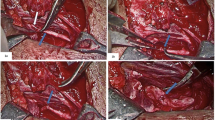Abstract
Purpose of the Review
The goal of this chapter is to present the most up-to-date options in managing unilateral vocal fold paralysis (VFP) in the pediatric population. As this condition affects multiple systems, and options are multiple, it is important to be aware of the potential risks and benefits of each possibility in order to facilitate informed decision making.
Recent Findings
The use of laryngeal electromyography in the workup of VFP has more recently been popularized as an adjunct in the diagnosis and prognosis for recovery. Moreover, advances in laryngeal reinnervation surgery show promise in the pediatric population. Finally, laryngeal pacing and the use of fibroblast growth factors are important new future directions in the field.
Summary
Management of unilateral vocal fold paralysis in children can be challenging with many treatment options available. A personalized and tailored approach to each patient is warranted.
Similar content being viewed by others
References
Papers of particular interest, published recently, have been highlighted as:•• Of major importance
Setlur J, Hartnick CJ. Management of unilateral true vocal cord paralysis in children. Curr Opin Otolaryngol Head Neck Surg. 2012;20(6):497–501.
Jabbour J, et al. Pediatric vocal fold immobility: natural history and the need for long-term follow-up. JAMA Otolaryngol Head Neck Surg. 2014;140(5):428–33.
Chen EY, Inglis AF Jr. Bilateral vocal cord paralysis in children. Otolaryngol Clin N Am. 2008;41(5):889–901. viii
King EF, Blumin JH. Vocal cord paralysis in children. Curr Opin Otolaryngol Head Neck Surg. 2009;17(6):483–7.
Hartnick CJ, et al. Surgery for pediatric vocal cord paralysis: a retrospective review. Ann Otol Rhinol Laryngol. 2003;112(1):1–6.
Alfares FA, et al. Outcomes of recurrent laryngeal nerve injury following congenital heart surgery: a contemporary experience. J Saudi Heart Assoc. 2016;28(1):1–6.
Daya H, et al. Pediatric vocal fold paralysis: a long-term retrospective study. Arch Otolaryngol Head Neck Surg. 2000;126(1):21–5.
Farhood Z, et al. Pediatric recurrent laryngeal nerve reinnervation: A case series and analysis of post-operative outcomes. Int J Pediatr Otorhinolaryngol. 2015;79(8):1320–3.
Tibbetts KM, et al. Etiology and long-term functional swallow outcomes in pediatric unilateral vocal fold immobility. Int J Pediatr Otorhinolaryngol. 2016;88:179–83.
Hirsch AW, et al. Characteristics of children hospitalized with aspiration pneumonia. Hosp Pediatr. 2016;6(11):659–66.
Shah RK, et al. Perceptual voice characteristics in pediatric unilateral vocal fold paralysis. Otolaryngol Head Neck Surg. 2006;134(4):618–21.
Sipp JA, et al. Vocal fold medialization in children: injection laryngoplasty, thyroplasty, or nerve reinnervation? Arch Otolaryngol Head Neck Surg. 2007;133(8):767–71.
de Gaudemar I, et al. Outcome of laryngeal paralysis in neonates: a long-term retrospective study of 113 cases. Int J Pediatr Otorhinolaryngol. 1996;34(1–2):101–10.
Wentland CJ, Song PC, Hartnick CJ. Voice and swallowing disorders related to vocal fold immobility : the use of laryngeal EMG. Curr Treat Options Peds (2016) 2:339-351
Maturo S. Pediatric laryngeal electromyography. Adv Otorhinolaryngol. 2012;73:86–9.
Berkowitz RG, Ryan MM, Pilowsky PM. Respiration-related laryngeal electromyography in children with bilateral vocal fold paralysis. Ann Otol Rhinol Laryngol. 2009;118(11):791–5.
Zur KB, Carroll LM. Recurrent laryngeal nerve reinnervation in children: acoustic and endoscopic characteristics pre-intervention and post-intervention: a comparison of treatment options. Laryngoscope. 2015;125(Suppl 11):S1–15.
Smith ME, Houtz DR. Outcomes of laryngeal reinnervation for unilateral vocal fold paralysis in children: associations with age and time since injury. Ann Otol Rhinol Laryngol. 2016;125(5):433–8.
Carroll TL, Rosen CA. Long-term results of calcium hydroxylapatite for vocal fold augmentation. Laryngoscope. 2011;121(2):313–9.
Young V. Y. V. Y. N., Simpson S. B. Treatment of vocal fold paralysis. In: Johnson J. T., Rosen C. A., editors. Bailey's Head & Neck Surgery Otolaryngology. 5th. Philadelphia, Pa, USA: Wolters Kluwer; 2014;1018
Mallur PS, Rosen CA. Vocal fold injection: review of indications, techniques, and materials for augmentation. Clin Exp Otorhinolaryngol. 2010;3(4):177–82.
PROLARYN. GEL and PROLARYN PLUS (combined instructions for use). Merz North America, Inc: Greensboro; 2014.
Link DT, et al. Pediatric type I thyroplasty: an evolving procedure. Ann Otol Rhinol Laryngol. 1999;108(12):1105–10.
Daniero JJ, Garrett CG, Francis DO. Framework surgery for treatment of unilateral vocal fold paralysis. Curr Otorhinolaryngol Rep. 2014;2(2):119–30.
Butskiy O, Mistry B, Chadha NK. Surgical interventions for pediatric unilateral vocal cord paralysis: a systematic review. JAMA Otolaryngol Head Neck Surg. 2015;141(7):654–60.
Smith ME. Pediatric ansa cervicalis to recurrent laryngeal nerve anastomosis. Adv Otorhinolaryngol. 2012;73:80–5.
Smith ME, Roy N, Houtz D. Laryngeal reinnervation for paralytic dysphonia in children younger than 10 years. Arch Otolaryngol Head Neck Surg. 2012;138(12):1161–6.
Nestor KA et al. Neurodevelopmental outcomes in infants undergoing general anesthesia. J Pediatr Surg. 2017;52(6):895-900.
Vutskits L, Davidson A. Update on developmental anesthesia neurotoxicity. Curr Opin Anaesthesiol. 2017;30(3):337-342.
Hirano S, et al. Regenerative phonosurgical treatments for vocal fold scar and sulcus with basic fibroblast growth factor. Laryngoscope. 2013;123(11):2749–55.
Kanazawa T, et al. Injection of basic fibroblast growth factor for unilateral vocal cord paralysis. Acta Otolaryngol. 2017:1–6.
Kanazawa T, et al. Single injection of basic fibroblast growth factor to treat severe vocal fold lesions and vocal fold paralysis. Laryngoscope. 2015;125(10):E338–44.
Mueller AH, et al. Laryngeal pacing via an implantable stimulator for the rehabilitation of subjects suffering from bilateral vocal fold paralysis: a prospective first-in-human study. Laryngoscope. 2016;126(8):1810–6.
•• Mueller AH, et al. Laryngeal pacing for bilateral vocal fold paralysis: voice and respiratory aspects. Laryngoscope. 2017;127(8):1838–44. Laryngeal pacing is one of the most recent and new developments in the field of vocal fold paralysis. This is a landmark article on the topic
Author information
Authors and Affiliations
Corresponding author
Ethics declarations
Conflict of Interest
The authors declare that they have no conflict of interest.
Human and Animal Rights and Informed Consent
This article does not contain any studies with human or animal subjects performed by any of the authors.
Additional information
This article is part of the Topical Collection on Pediatric Otolaryngology
Rights and permissions
About this article
Cite this article
Bouhabel, S., Hartnick, C.J. Unilateral Vocal Fold Paralysis in Children: State-of-the-Art Treatment. Curr Otorhinolaryngol Rep 5, 240–244 (2017). https://doi.org/10.1007/s40136-017-0169-x
Published:
Issue Date:
DOI: https://doi.org/10.1007/s40136-017-0169-x




